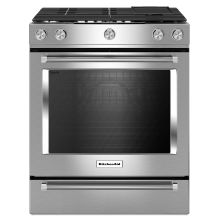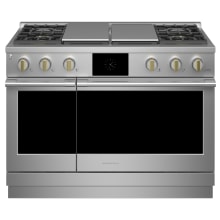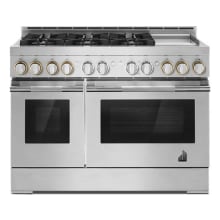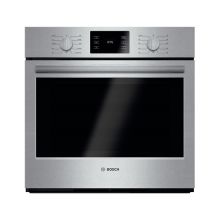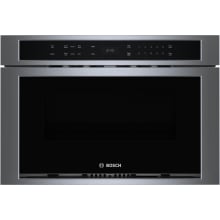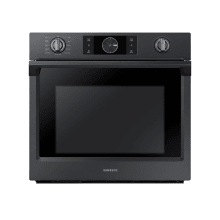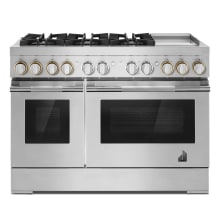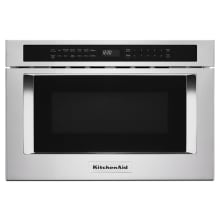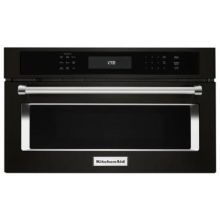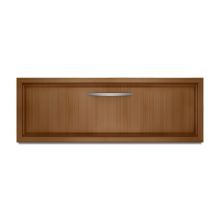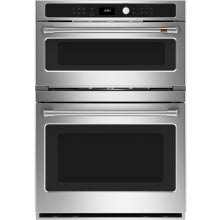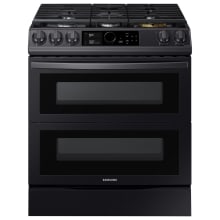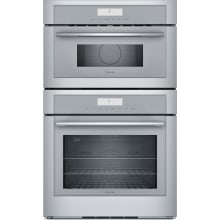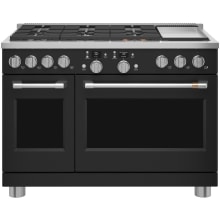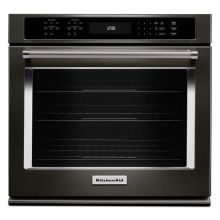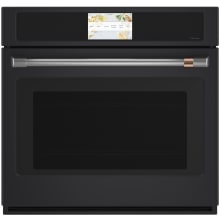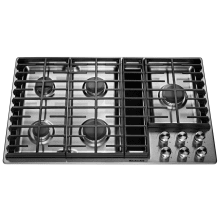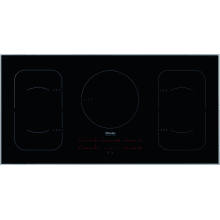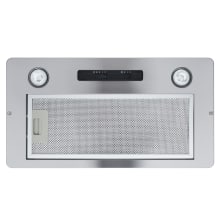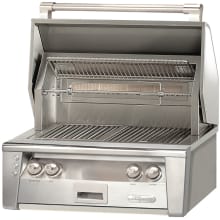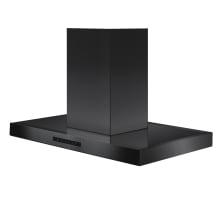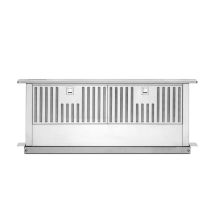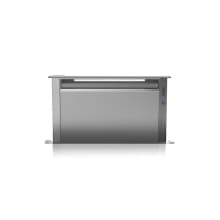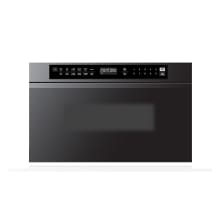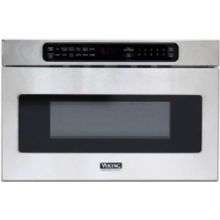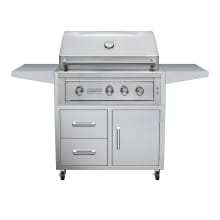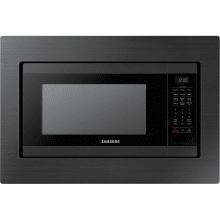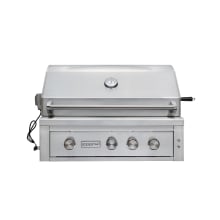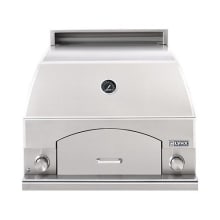Cooking Appliances Buying Guide
Cook in style when you choose essential kitchen appliances, including ranges, cooktops, ovens, microwaves, and more.
The kitchen is the heart of the home and the cooking appliances you choose may just be the heartbeat. Taking all your favorite ingredients and getting them from the grocery store to the table requires choosing wall ovens, ranges, cooktops, and other cooking appliances that will help you prepare your favorite dishes. Ovens and other cooking appliances are used nearly every day and can account for a significant portion of your kitchen remodeling budget. We’ve put together this buying guide to help you make the right choice for your space and the way you cook.
Ranges
Ranges combine an oven and a cooktop in one convenient unit. These are a staple in most home kitchens because they provide a lot of functions in a single appliance. This can be especially important in apartments, condominiums, and other homes with a small kitchen, as there may not be enough space for a separate wall oven and cooktop. Ranges can be installed along with standard cabinetry elements and do not require the more custom installation that wall units do, making them an easy option for anyone doing their own home renovations, as well.
Types of Ranges
Determining which range is ideal for your kitchen comes down to understanding the different types of ranges. Freestanding ranges, drop-in ranges, and slide-in ranges all offer different benefits. If you love spending time in the kitchen, you can even upgrade to professional-grade ranges of various types.
- Freestanding Ranges have finished sides and can be placed anywhere in the kitchen.
- Drop-In Ranges are placed between cabinets and do not have finished sides that allow them to stand independently of surrounding cabinetry. They are meant to sit on top of a finished cabinet panel rather than on the floor. It’s the cabinetry that gives drop-in ranges their finished look.
- Slide-In Ranges are placed between cabinets and do not have finished sides. Unlike drop-in ranges, slide-in models sit on the floor.
Range Sizes
Ranges are designed to nestle into your lower cabinetry, so they need to be the right fit. If you already have cabinetry in place, measure the open area allotted for a range and choose a range within those dimensions. As you measure, document the width of the opening, depth of the opening, and height from floor to countertops. If you are decorating an all-new kitchen or extensive remodel, you may want to choose your appliances first and build the cabinetry to accommodate the dimensions of the range you’ve selected.
Cooktops
Cooktops are horizontal cooking surfaces utilizing burners that allow you to sear, sauté, and cook items in pots and pans. They are often built into the lower cabinetry and countertops or even the kitchen island. Cooktops can also be incorporated into a range, which combines cooktops with lower ovens. Depending on what type of cooktop you purchase, they can be crafted of glass, ceramic, and other materials.
When you choose wall ovens over ranges, you’ll also need to shop for a cooktop to complete your kitchen design. Cooktops are a series of burners that install directly into your countertops, free from an attached oven. These appliances free up the lower area for cabinetry, including deep drawers capable of holding even your largest pots and pans.
Cooktops are typically installed when you’ve selected a wall oven. Ovens are often arranged off to the side in a kitchen, keeping them out of the way when you are preparing the rest of your meal. Cooktops, however, are in the heart of your kitchen because you typically need to attend to the items being prepared on a cooktop more frequently.
Electric coil, smooth, induction, and gas cooktops all allow you to adjust the temperature of each burner. Set some pots to simmer, others to boil, and enjoy all cooking temperatures in between using either an electric touch panel or a series of knobs. The number of burners included in each cooktop varies, so consider both the amount of space you have available and the number of burners you need to cook all your favorite food items simultaneously.

Smooth Cooktops
Smooth top cooktops feature a flat glass/ceramic surface with heating elements underneath. The surface is easy to clean and generally includes indicator lights to show which elements are still hot. These can include traditional electric cooktops that produce heat, as well as heatless electromagnetic induction cooktops.
Coil Cooktops
Coil cooktops include metal burners with electric coils. Drip pans beneath the coils can be removed for cleaning. The elements can be slow to heat and cool down. These cooktops are generally the least expensive.
Gas Cooktops
Gas Cooktops feature burners with open flames. Gas burners are easy to adjust to a specific temperature and generally provide more even heating, making them a favorite of professional chefs. In fact, as you adjust the temperature, the height of the flame changes. Gas burners also provide for more customizable cooktops, such as optional griddles. The fact that they provide an open flame even allows you to put peppers and other items directly over the open flame to char the outside of the item.
Induction Cooktops
Induction cooktops use electromagnetic heating elements below the surface. Induction cooktops are generally more expensive than other options because of the specialized heating methods.
The element on an induction cooktop will only heat up if a piece of cookware containing magnetic material is used, so special pots and pans are required. Induction cooktops heat up fast when the cookware is in contact, then cool down immediately after the cookware is removed, making them safer and more energy efficient than standard cooktops. Because the burners themselves never get hot, these are by far the safest way to cook with children.
Wall Ovens
The oven, or wall oven, is an enclosed compartment where food is heated, baked, or roasted. Ovens are also part of a range which includes a cooktop. Wall ovens are separate appliances without an attached cooktop. Both single and double wall ovens are available, expanding your cooking options. Some models even offer a self-cleaning feature that uses high temperatures to turn food residue into ash for easy disposal, or high heat and steam to soften stuck-on food.
Conventional Vs. Convectional Wall Ovens
Wall ovens fall into one of two categories: convection vs. conventional. Understanding the difference between convection and conventional ranges and wall ovens will help you determine which one makes the best choice for your kitchen.
- Conventional: Conventional ovens feature traditional coil-heating elements for baking and broiling your favorite dishes.
- Convection: Convection ovens use fans to move hot air within the compartment for faster, more even cooking. Many convection ovens give you the option of baking conventionally or turning on the convection feature.
Wall Oven Configuration
Once you’ve decided to showcase a wall oven in your kitchen, there are three basic configurations to choose from, including:
- Single Wall Ovens: You don’t need a large space to accommodate a single wall oven. This is the most common arrangement of wall oven.
- Wall Oven/Microwave Combos: Maximize functionality in your kitchen by choosing an oven and microwave combination. These stacked appliances are easy to install into your cabinetry and provide you with two cooking options in one designated area.
- Dual Wall Ovens: Dual ovens have independent heat controls, allowing separate dishes to be cooked at different temperatures, making it easy to prepare an entree and side dishes at the same time. When you’re an avid home cook that prepares food for a lot of people, this wall oven is worth the space and the investment.
Range Hood
Range hoods provide the ventilation needed when you use your cooktop, helping to keep the moisture of cooking steam from damaging the surfaces in your kitchen over time. If dinner gets a little charred, the range hood pulls the smoke from the area over the stove or oven rather than let it set off the smoke detectors. They also help to remove small food particles and odors from the air throughout the room. They often incorporate lighting to help keep the cooking area fully illuminated and safer.
Although functional, range hoods can also be a stylish addition to your kitchen design. If you have a cooktop or range in your home, you require a range hood. Fortunately, there’s a comprehensive article that will help you learn how to choose a range hood.
Ducted Vs. Ductless Range Hoods
Ducted range hoods vent directly outside of the home, making them the most efficient choice for ventilation. These range hoods are most frequently used when the range is located along an exterior wall of the home because of the ability to run a duct out the top of the wall or through the roof itself.
Ductless range hoods don’t require exterior access, which makes them a much more versatile choice. They can be installed anywhere in the kitchen without adding additional pipes or ductwork. They are the more common choice in apartment buildings, townhomes, and condominiums that may not have kitchens arranged along exterior walls.
Range Hood Sizes
Generally, the range hood should be the same width as the cooktop located below it. Choose your cooktop first and then select a range hood size that’s the proper scale for the appliance it supports. Factor in the potential arrangement of the lighting provided by most range hoods and what layout will ultimately help out most with daily cooking projects.
Range Hood Blower Types
Range hood blowers are what actually provide the power needed for the hood to gather up smoke, steam, food particles, and odors. Range hoods offer one of three types of blowers, including:
- Built-In Blowers: These internal blowers are already installed into the range hood or can be installed inside the range hood for built-in results.
- In-Line Blowers: Aren’t installed in the range hood itself, but rather into the rafters or the floorboards.
- External Blowers: These blowers are outside of the range hood itself and installed in the side wall or the roof of your home.
Microwaves
Microwave ovens use radio waves to agitate water molecules in food. The vibration of the water molecules generates heat to cook the food much faster than a conventional oven.
Whether you’re making popcorn for a home movie or reheating leftovers, microwaves are sure to be one of the most-used appliances in your kitchen. While technically these don’t fall into the category of an oven, they are often installed in tandem with wall ovens and ranges as an alternative way to cook your food or reheat leftovers.
Types of Microwaves
There are three primary types of microwaves available to you, including over-the-range microwaves, built-in microwaves, drawer microwaves, and countertop microwaves. Understanding the distinctions between these different types of microwaves will help you choose the best one for your kitchen.
- Countertop Microwaves: These are typically the most affordable options, but they do take up valuable countertop space. These units come in a range of sizes and are portable units that you can store in a closet when not in use. The main benefit of countertop microwaves is that they can easily be moved from one property to another. If you’re renting, they also don’t require any changes to the kitchen itself.
- Over-the-Range Microwaves: These microwaves mount directly over your range and often feature built-in ventilation that allows them to double as the range hood.
- Built-In Microwaves: Built-in microwaves are designed for installation in your cabinetry design. They are often installed above a wall oven or in the cabinetry of a kitchen island.
- Drawer Microwaves: One of the most innovative options for microwaves is the drawer microwave. This microwave installs into your lower cabinetry and offers a slide-out drawer as opposed to a swing-out door. This makes it a much more accessible choice for people in wheelchairs or who are not tall enough to reach into a traditional above-range or built-in microwave safely. A drawer microwave typically offers a larger interior than other types of microwaves.
Microwave Features
When it comes to microwaves, different models can offer very different features. Narrowing down your search for the best microwave for your home often comes down to choosing one that offers the right features. As you shop, make sure to consider:
- Capacity: The external dimensions of the microwave help ensure a great fit within your cabinetry, but the internal dimensions of the microwave determine the capacity. The internal capacity will help you know what size dishes the microwave will accommodate.
- Wattage: The wattage refers to the amount of power output for the microwave. The higher the wattage, the better the performance of the appliance. Make sure to select microwaves with a wattage of 800 or more.
- Presets: Most microwaves offer pre-set options that make it easy to cook items at the ideal temperature and for the ideal length of time. Look for presets that will make it easy to warm up the items you like to cook in your microwave, from hot drinks to popcorn.
Warming Drawers
Warming drawers are a convenient addition to your kitchen as they hold your dishes at a warm temperature until they’re ready to be served. This helps you serve multiple dishes, all at the ideal temperature. Some warming drawers can even slow-cook items.
Shopping for Cooking Appliances by Fuel Type
Before you can begin shopping for the best cooking appliances for your home, you must first determine what fuel type your home uses to power these appliances. While the exact price of electricity and gas can vary based on where you live, generally it is cheaper to run gas appliances than it is to run electrical appliances for the same amount of time.
If you are bringing in appliances from another home, there are gas to electric conversion kits available. If you want to convert an electric appliance to gas, however, you’ll need to call in a professional electrician. For more information about how to choose between gas and electric appliances, check out our buying guide.
Electric Cooking Appliances
Electric appliances tap into your home’s electricity using a traditional plug and are among the most common fuel types for appliances, as many homes don’t have gas lines available. In general, electric appliances tend to heat more evenly and maintain a more consistent temperature than gas appliances, making them a desired fuel type for ovens specifically. They also provide a drier cooking environment, which is preferable when baking.
Gas Cooking Appliances
Some homes are built with gas lines that power their indoor and outdoor appliances, including water heaters, ranges, cooktops, ovens, and even washers and dryers. While this fuel type doesn’t heat food as evenly, it's less likely to dry out your roasts and meats, making them a desirable fuel type for many avid cooks. Gas ranges still use a bit of electricity for the ignition that sparks the flames. Of course, one of the drawbacks to using gas cooktops and ranges is that they can be less than ideal when you want to teach children how to cook.
Dual Fuel Cooking Appliances
Dual-fuel ranges have a gas cooktop and an electric oven, offering the unique cooking benefits of both fuel types. You get the consistent heating achieved by electric ovens and the incredible performance and instant heat offered by a cooktop powered by gas with an adjustable height open flame.
Outdoor Cooking Appliances
Cooking appliances aren’t limited to indoor use. Today, there are a wide range of cooking appliances specifically designed to be part of your outdoor kitchen. Outdoor cooking appliances are designed to hold up to the elements and can be a great addition to your outdoor rooms. Grills, smokers, and pizza ovens are among the most popular cooking appliances added to outdoor kitchens. A well-stocked outdoor kitchen can be equipped with virtually everything you could find in an indoor kitchen, it’s all up to you and your culinary determination.
Shopping for Smart Appliances
When shopping for the ideal cooking appliances for your kitchen, consider shopping for smart appliances. These kitchen essentials take convenience to the next level by allowing you to control your range or other kitchen appliance from the convenience of an app. Imagine how convenient it would be to preheat your oven as you leave the grocery store with your dinner ingredients. Discover the ideal cooking appliances for your home at Build with Ferguson.















